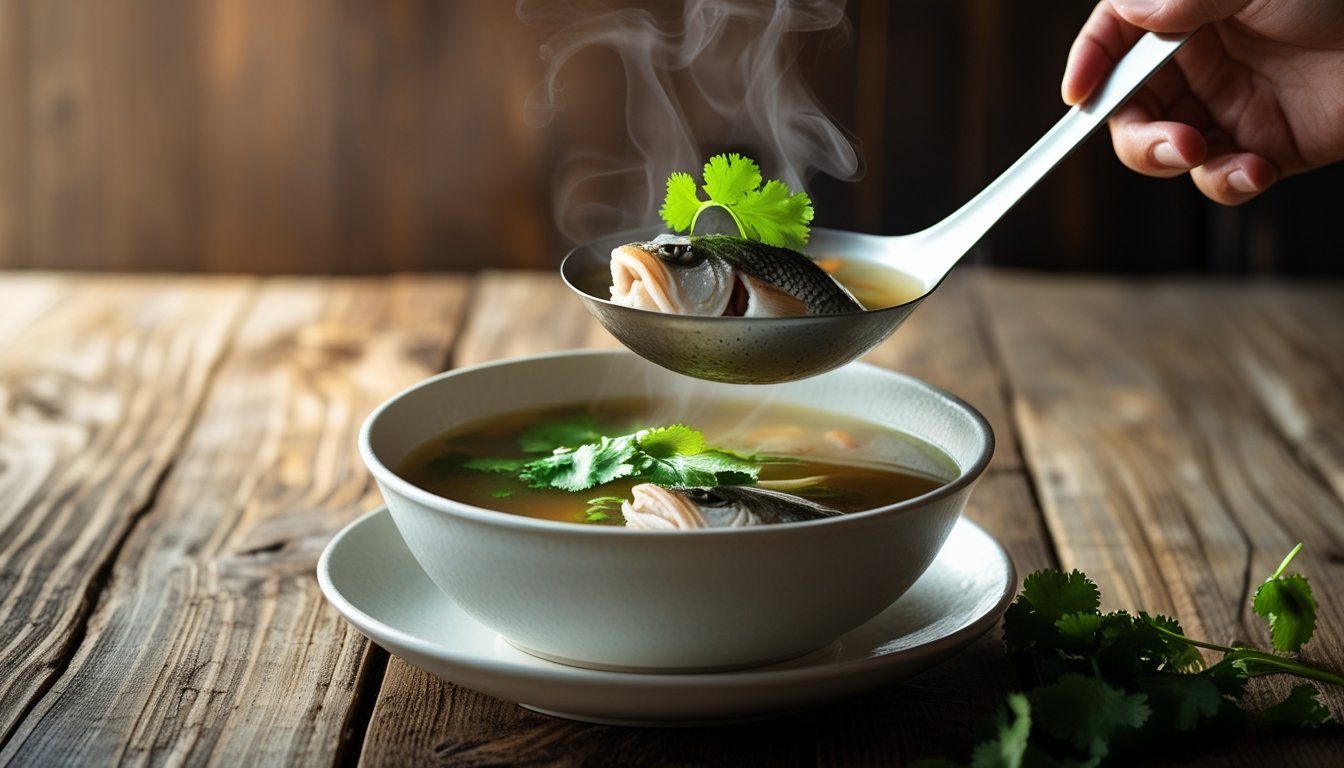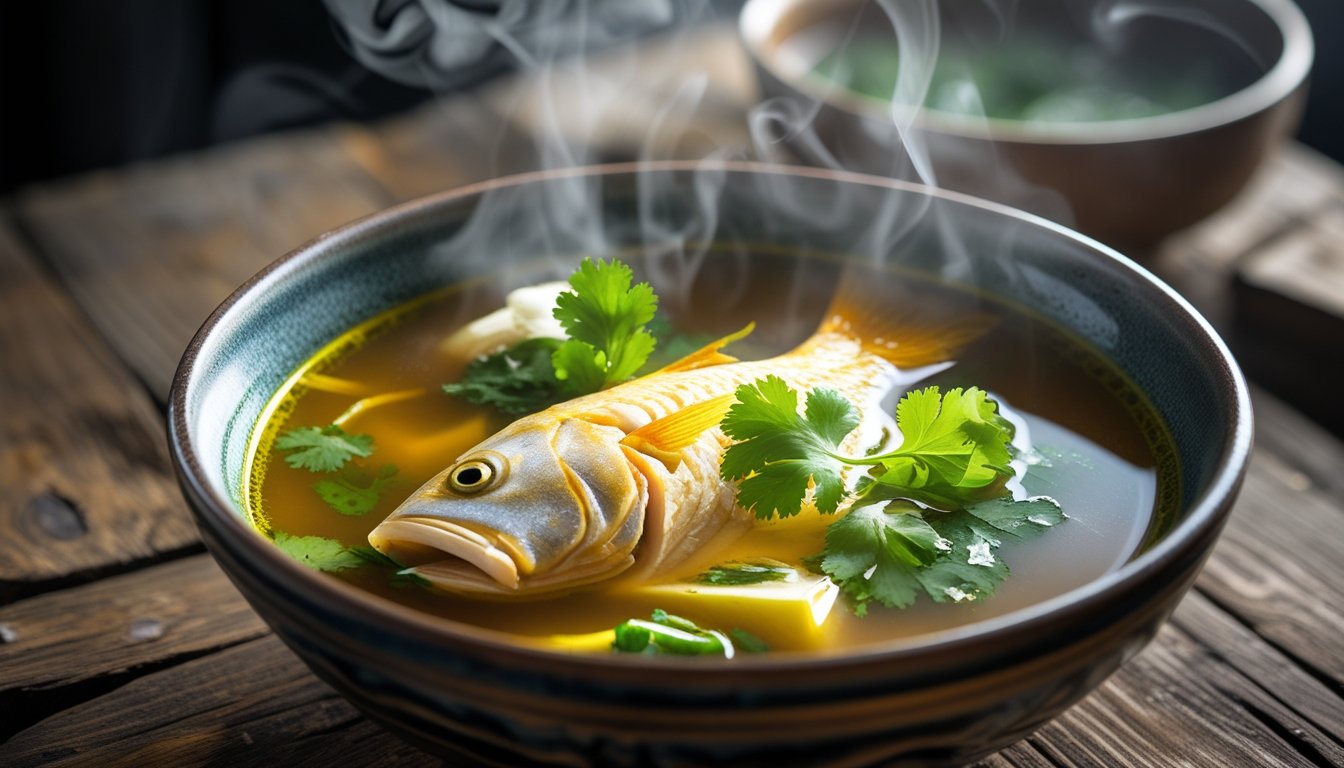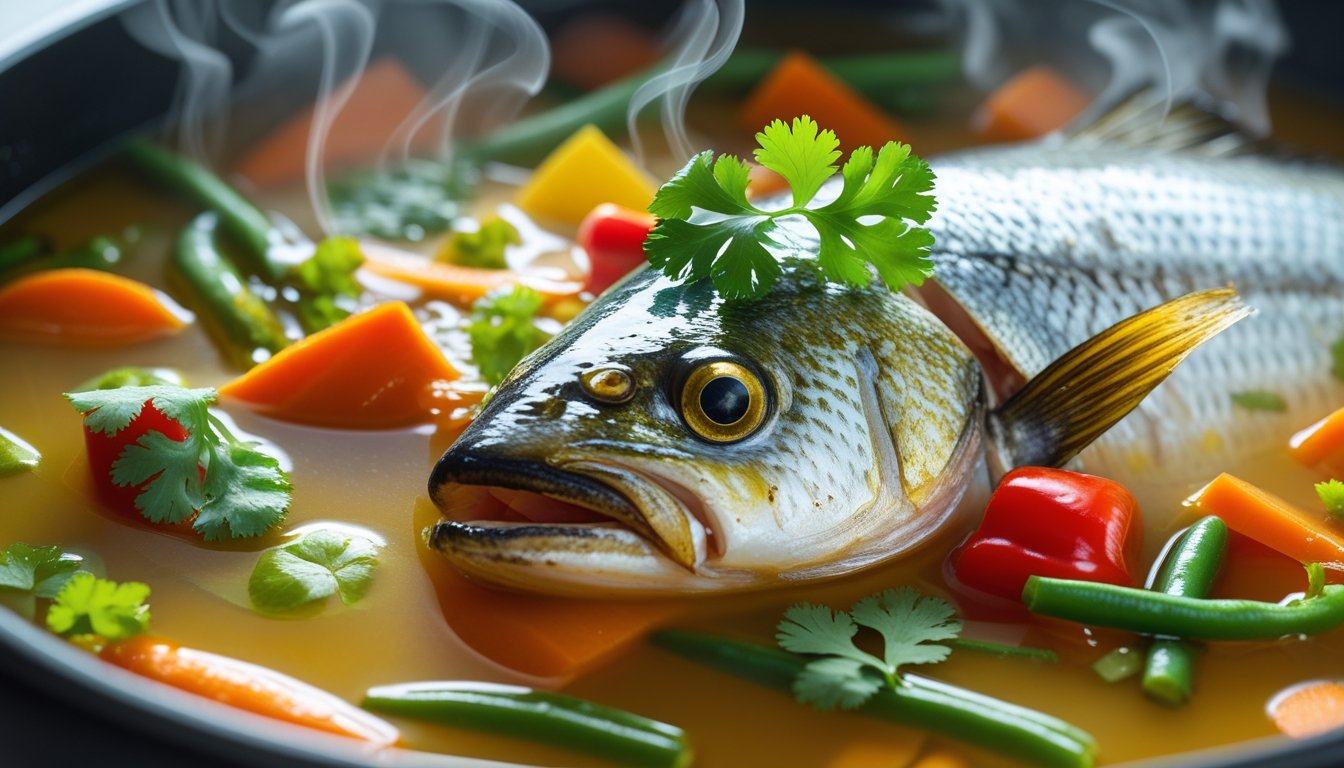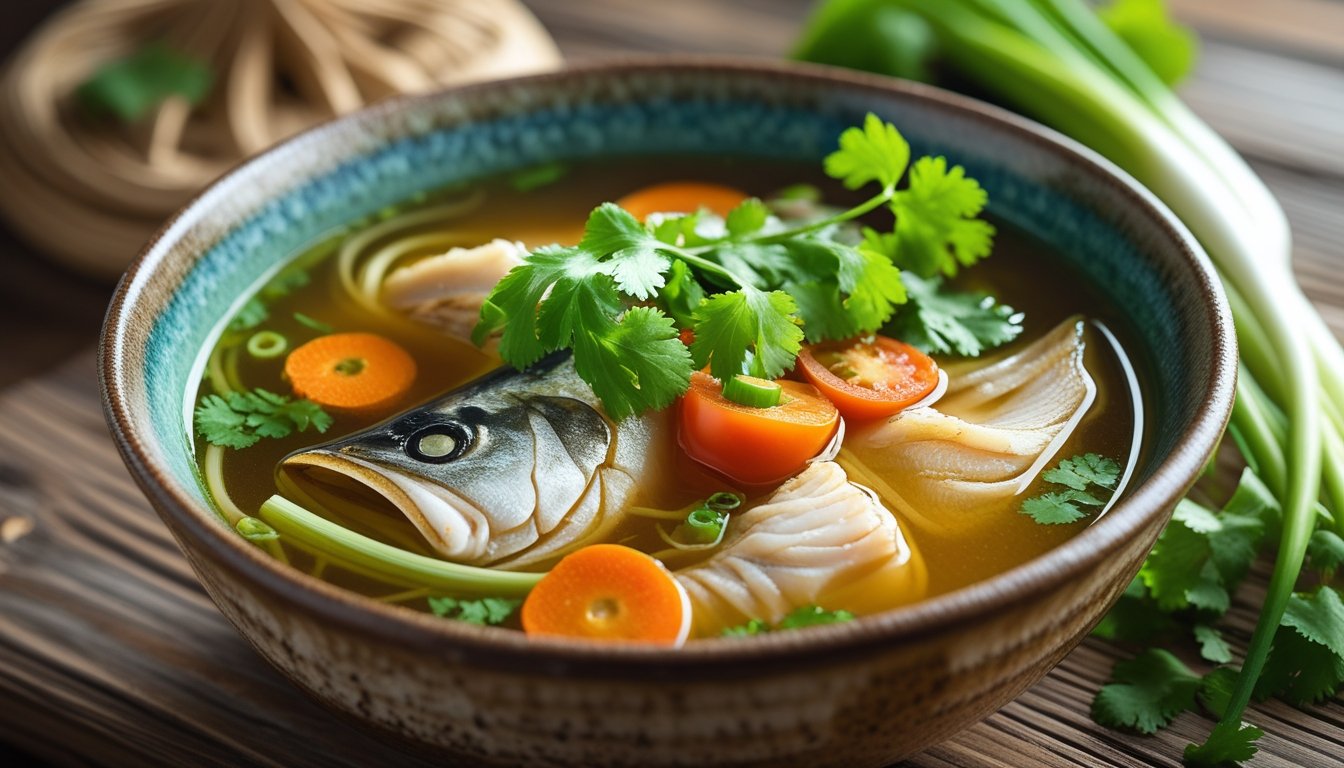Hey there! So, you’ve probably walked past the fish section at the market, stared at a fish head, and thought, “Uh… what do I do with this?” I get it. Fish heads can look intimidating at first glance, but trust me—they are absolute flavor powerhouses.
Seriously, if you’ve ever wondered why soups at restaurants taste so rich and “deep,” it’s probably because of the magic that fish heads bring. Today, I’m going to walk you through my quick fish head soup recipe that’s easy, tasty, and perfect for any day you want a comforting meal without spending hours in the kitchen.
Before we jump into the steps, let’s talk about why fish head soup deserves a spot on your table. The flavor? Unbeatable. The health benefits? Fantastic. And yes, it’s way easier than you think. In fact, once you get the hang of it, you might start hunting down fish heads at the market just because they’re that good.
Looking for a quick fish head soup recipe that’s both tasty and simple to make? You’re in the right place! This easy-to-follow recipe delivers a rich, flavorful broth packed with nutrients, perfect for a comforting meal anytime.
Using a fresh fish head, aromatics like ginger, garlic, and onion, and a few simple vegetables, you can create a restaurant-quality soup right in your own kitchen. Not only does it taste amazing, but it’s also full of omega-3s, collagen, and calcium, making it a healthy choice for the whole family.
Start by prepping your fish head properly—rinse it well and remove the gills for a cleaner flavor. Sauté your ginger, garlic, and onion in a pot until fragrant, then add the fish head and enough water to cover. Let it simmer gently so the flavors infuse perfectly.
Next, add vegetables such as carrot, tomato, and spring onions, and season with salt, pepper, and a touch of fish sauce for depth. Continue simmering until the fish is tender and the broth is flavorful. Taste and adjust seasoning as needed.
Finally, serve your soup hot, garnished with fresh herbs like cilantro or parsley, and optionally drizzle with sesame oil for extra aroma. This fish head soup is versatile—you can try spicy, coconut, or noodle variations depending on your taste. Perfect for busy weeknights or lazy weekends, this recipe guarantees satisfaction. For all details on ingredients, steps, and tips, check the complete recipe in given below.

Why Fish Head Soup is So Good
Let’s break it down. Fish heads are packed with umami, the savory taste that makes you want to keep slurping soup even when you’re full. The bones, the oils, and even the collagen in the head contribute to a broth that is silky, rich, and absolutely satisfying. This is why professional chefs swear by fish heads for soups and stocks—it’s like flavor concentrated in one ingredient.
And it’s not just taste. Fish heads are loaded with nutrients. You get omega-3 fatty acids, which are excellent for your heart and brain. They’re also rich in calcium and phosphorus, which are essential for strong bones, and the collagen can actually help your skin look a little more radiant. Honestly, who doesn’t want a meal that tastes incredible and makes you feel a bit healthier?
Ingredients You’ll Need
Okay, here’s the good news: this recipe doesn’t ask you to track down anything exotic. Most of these ingredients you probably already have at home:
- 1 large fish head (salmon, grouper, or tilapia work best)
- 4 cups of water
- 1 thumb-sized piece of ginger, sliced
- 2 cloves garlic, minced
- 1 medium onion, chopped
- 2-3 stalks spring onions, chopped
- 1 tomato, chopped
- 1 carrot, sliced
- Salt and pepper to taste
- 1 teaspoon fish sauce or soy sauce (optional, but recommended for depth)
Optional but awesome:
- A few dried shiitake mushrooms for earthy flavor
- A dash of sesame oil for aroma
- Cilantro or parsley for garnish
See? Totally manageable. No need for fancy ingredients or a PhD in cooking.
Step 1: Prepping Your Fish Head
Alright, let’s start at the beginning. First things first: rinse that fish head thoroughly under cold water. Make sure there’s no leftover blood or scales. It might look a little intimidating, but don’t worry—you’ll tame it in a second. If you want a cleaner taste, I recommend removing the gills.
They can make the broth bitter, and we definitely don’t want that. Pat the fish head dry before you start cooking—it helps prevent splattering when it hits the hot pot. I know some people skip this step, but trust me, a little prep now saves headaches later.
Step 2: Sautéing the Aromatics
Now comes the fun part. Heat a small amount of oil in a pot and toss in your ginger, garlic, and onion. Give them a few minutes to sizzle and release those heavenly aromas. If your kitchen suddenly smells like a five-star restaurant, congratulations—you’re doing it right.
Sautéing these aromatics first is key to building a flavorful base. Don’t rush it; let the smell guide you. I often find myself sneaking tastes of the aromatics just because they smell so good.
Step 3: Adding the Fish Head and Water
Time to bring in the star of the show! Carefully place your fish head into the pot—it might splash a bit, so watch your sleeves. Pour in enough water to cover the head, usually about four cups. Bring everything to a boil, then reduce it to a gentle simmer. This simmering is where all the magic happens. The bones release gelatin and flavor into the water, turning it into a rich, comforting broth. FYI, this is also the moment where your kitchen starts to smell ridiculously good, and you’ll probably start drooling a little.
Step 4: Adding Vegetables and Seasoning
Once your fish head is simmering, it’s time to add some color and texture. Toss in the carrot, tomato, and spring onions, and season with salt, pepper, and fish or soy sauce. If you decided to include mushrooms, throw them in now as well.
This step really transforms your broth from “meh” to something vibrant and flavorful. Don’t skimp on seasoning; it’s the difference between a forgettable soup and something you’ll be bragging about to friends. I always taste as I go—because who wants bland soup?
Step 5: Simmering to Perfection
Let the soup simmer for about 15-20 minutes. Be gentle here. Overcooking the fish head can make the meat mushy, and we don’t want that. You want the meat tender but still intact, and the broth perfectly infused with all the flavors.
This is the kind of patience that really pays off. I usually sit nearby and sneak little smells and sips, just to make sure it’s coming together perfectly. Trust me, it’s worth the watch.
Step 6: Final Taste Test and Adjustments
Now comes the most important step: tasting. Grab a spoon and see how the flavor is coming along. Need a little more salt? Add it. Pepper too flat? Throw some in. Fish sauce too weak? Boost it slightly. This is your moment to make the soup truly your own. Remember, cooking is part science, part intuition. If it tastes good to you, it’s perfect. I always find myself making tiny adjustments here—it’s amazing how a pinch of salt or a splash of fish sauce can elevate the soup entirely.
Step 7: Serving and Garnishing
Finally, pour your soup into bowls, making sure everyone gets a nice piece of fish head if you’re serving friends or family. Sprinkle with fresh cilantro or parsley, and for that little restaurant touch, add a tiny drizzle of sesame oil. The colors pop, the aroma hits you instantly, and honestly? It looks like something straight out of a culinary magazine. Plus, that first spoonful… oh man, it’s pure heaven.

Tips for the Perfect Fish Head Soup
Even though this is a “quick” recipe, a few extra tips can make it truly unforgettable:
- Always use fresh fish heads. Smelly or old fish will ruin the broth.
- Keep your simmer low. Boiling too hard makes the meat fall apart.
- Layer your flavors: sauté aromatics first, then veggies, then seasoning.
- Herbs are your friends. Thyme, dill, or even lemongrass can elevate the soup.
- Leftovers? No problem. Store in an airtight container for up to two days, and reheat gently to keep the fish tender.
Variations to Try
Why stick to one version when you can experiment?
- Spicy Fish Head Soup: Add fresh chili peppers or hot sauce for a fiery kick.
- Coconut Fish Head Soup: Replace half the water with coconut milk and a squeeze of lime for a tropical twist.
- Noodle Soup Version: Toss in some rice or egg noodles for a hearty, complete meal.
- Clear vs. Creamy: Simmer shorter for a light broth, or blend cooked vegetables for a creamy texture.
Honestly, I’ve tried them all, and each variation has its own charm. IMO, the coconut version is surprisingly addictive.
Common Mistakes to Avoid
Even seasoned cooks make these errors:
- Skipping aromatics (your broth will taste flat).
- Overcooking the fish head (mushy meat = sad soup).
- Ignoring seasoning (always taste as you go).
- Using frozen or old fish heads (freshness = flavor).
Avoid these, and you’re on the fast track to soup greatness.
Why This Recipe Works for Busy People
Let’s be real—life is hectic. We don’t always have hours to spend in the kitchen. This quick fish head soup recipe takes under 30 minutes, uses minimal ingredients, and delivers maximum flavor. Perfect for weeknight dinners, lazy weekends, or impressing friends without breaking a sweat. You don’t need fancy skills, just some basic kitchen know-how and a little love.
Serving Suggestions
Here’s how I personally enjoy mine:
- Serve with steamed rice—classic combo.
- Sometimes I cheat with garlic bread, because carbs.
- Fresh herbs like cilantro or parsley add freshness and color.
- A squeeze of lime juice before serving lifts the flavors beautifully.

FAQs About Fish Head Soup
Q: Can I use any type of fish head?
A: Yep! Salmon, tilapia, grouper, or snapper all work. Just make sure it’s fresh.
Q: Can I eat the eyes?
A: Totally edible, though some people skip them. Your call.
Q: How long can I store leftovers?
A: Up to 2 days in the fridge, in an airtight container. Reheat gently.
Q: Can I make it spicy?
A: Absolutely! Fresh chili, chili oil, or hot sauce will do the trick.
Final Thoughts
There you have it—a quick, tasty, and simple fish head soup recipe that anyone can make. No fluff, no complicated techniques, just rich, hearty flavor that warms you from the inside out. The first time I made this, I was a little skeptical about using the fish head—but after one spoonful, I was hooked. Now it’s a staple in my kitchen, and honestly, it might become yours too.
FAQs – Quick Fish Head Soup Recipe – Tasty & Simple to Make Today
Q1: What type of fish head is best for making fish head soup?
A: You can use a variety of fish heads, but fresh, meaty fish heads work best. Salmon, tilapia, grouper, or snapper are commonly used. Freshness is key—avoid fish heads that smell off or have cloudy eyes. The right fish head ensures a rich, flavorful broth.
Q2: How do I clean a fish head before cooking?
A: Rinse the fish head thoroughly under cold water. Remove the gills to prevent bitterness, and ensure any remaining blood or scales are cleaned off. Pat dry before adding to the pot to prevent splattering.
Q3: How long does it take to make quick fish head soup?
A: From prep to serving, this recipe takes about 30 minutes. The fish head cooks quickly, and simmering ensures the broth is rich without long hours on the stove.
Q4: Can I make fish head soup spicy?
A: Yes! Add fresh chili, chili oil, or hot sauce to taste. You can also add ginger and garlic to enhance the spicy, aromatic flavor.
Q5: What vegetables go well in fish head soup?
A: Common choices include carrots, tomatoes, spring onions, and mushrooms. These add texture, flavor, and color to the soup. You can also experiment with leafy greens or herbs like cilantro or parsley.
Q6: How do I store leftover fish head soup?
A: Store in an airtight container in the refrigerator for up to 2 days. Reheat gently to avoid overcooking the fish. Avoid freezing, as it may affect the texture of the fish meat.
Q7: Can I use frozen fish heads?
A: Yes, but fresh is always better. Frozen fish heads may affect the flavor and texture of the soup. If using frozen, thaw completely before cooking.
Q8: What is the health benefit of fish head soup?
A: Fish head soup is rich in omega-3 fatty acids, collagen, calcium, and phosphorus, making it good for heart health, bone strength, and skin wellness. It’s a nutritious, low-calorie, and wholesome meal option.
Q9: Can I make a creamy fish head soup?
A: Absolutely. Add some coconut milk or blended vegetables like carrots or potatoes for a creamy texture. This variation works well for a richer, thicker soup.
Q10: How do I prevent fish head soup from smelling fishy?
A: Use fresh fish, remove the gills, and sauté aromatics like ginger and garlic before adding the fish. Simmer gently and avoid overcooking—the fishy smell diminishes with proper preparation.
Q11: Can I make fish head soup with noodles?
A: Yes! Add rice noodles or egg noodles during the last few minutes of cooking for a hearty and complete meal. This is perfect for lunch or dinner on busy days.
Q12: Can this recipe be adapted for special diets?
A: Yes. For a low-sodium version, reduce salt and skip fish sauce. For a paleo or keto-friendly version, serve without noodles and avoid starchy vegetables. You can also experiment with organic or sustainably sourced fish heads.
Q13: Is fish head soup suitable for kids?
A: Definitely! Remove bones carefully, and consider mild seasoning. Fish head soup is packed with nutrients that are beneficial for growing children.
Q14: Can I add herbs for extra flavor?
A: Yes! Fresh cilantro, parsley, or dill enhances flavor and adds freshness. You can also experiment with lemongrass or thyme for unique twists.
Q15: Why is my fish head soup cloudy?
A: Cloudiness often happens if the soup is boiled too aggressively or the fish head wasn’t cleaned well. Simmer gently, skim off scum during cooking, and remove gills for a clear, appetizing broth.

